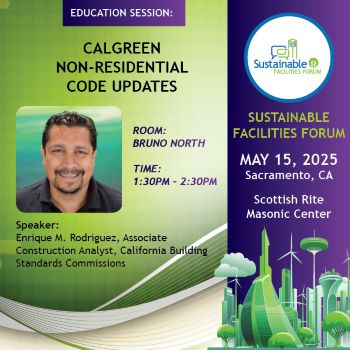CALCode Quarterly Spring 2025

 Stoyan Bumbalov
Stoyan Bumbalov
Spring sprang, and then it was winter again, and now it’s spring…and that’s how we roll in California’s capital city! I hope this edition of CALCode Quarterly finds you healthy and enjoying the changing of the seasons. The entire team here is saddened by the devastation caused by the fires in Southern California, and we are motivated to do everything we can to support rebuilding safe and resilient structures in the affected communities. Many building standards have already been proposed and adopted that address home hardening and wildland-urban interface fire danger mitigation, and state agencies will continue to look for ways to help protect communities.
As summer approaches, so does the July 1 publication date for the 2025 edition of the California Building Standards Code, Title 24 of the California Code of Regulations (Title 24). In the coming months, California Building Standards Commission (CBSC) staff will be completing the codification phase of the 2024 Triennial Code Adoption Cycle. This is the process whereby newly approved and adopted California code changes are incorporated into Title 24. Since some parts of Title 24 are based on model codes, which might also have updates, it is a painstaking task to ensure that past amendments are carried forward, new amendments are added appropriately, and everything is published properly for use by designers, builders, enforcement authorities, and other code users.
While we are wrapping up the 2024 Triennial Cycle, we are also kicking off the 2025 Intervening Code Adoption Cycle with pre-cycle workshops. The meetings held so far have been related to embodied carbon reduction, and future meetings will focus on electric vehicle charging, plumbing fixtures, and more embodied carbon. For those interested in participating in code development, pre-cycle workshops offer the opportunity to make the biggest impact with comments and suggested code language.
Read more about codification and pre-cycle activities in our Code Adoption Cycle Status article below.
Also below are detailed stories about CALGreen and a new addition to Title 24 – Part 7, the California Wildland-Urban Interface Code.
I am pleased to share that CBSC has a new office technician, Marissa Magdaleno. We are happy to have Marissa join the team to handle the front desk, phone calls, mail and many other administrative tasks. Learn more about Marissa in our Staff Spotlight article.
Finally, CBSC staff have been—and will be—out and about connecting with people and organizations involved with code adoption activities. In January and February, we had two meetings with representatives from Japan interested in California’s sustainable building codes. In March, CBSC and the Division of the State Architect met with leaders from the United States Green Building Council (USGBC) to discuss upcoming developments in the California Green Building Standards Code, Part 11 of Title 24 (CALGreen). Also in March, the California Fire Protection Institute heard about the commission, its roles and responsibilities, as well as recent code changes in CALGreen (the California Green Building Standards Code, Part 11 of Title 24). Coming up, we hope to see many of you at the California Building Officials (CALBO) annual business meeting in April, the Sustainable Facilities Forum in May, and at International Code Council (ICC) regional meetings. See our Education and Outreach sidebar for more information.
That’s it for now. Keep an eye out this summer for the next edition of CALCode Quarterly, when we will announce the publication of the 2025 Title 24 and the many CBSC resources to help everyone learn about code updates.
Feature Articles
2024 Triennial Code Adoption Cycle Codification and Title 24 Publication
The 2025 edition of the California Building Standards Code, Title 24 of the California Code of Regulations (Title 24) is currently in the final pre-publication phase, known as codification. This process comes after all code proposals have been approved and adopted by the California Building Standards Commission (CBSC) and filed with the Secretary of State. The steps include:
- CBSC sends the Final Express Terms (FET) to the publisher. This document contains code language as it is to be modified in Title 24, using underline to indicate new text and
strikethroughto indicate text to be removed. Also, for parts of Title 24 based on model codes, new California language is printed in italics. - The publisher merges the new code language into existing Title 24 parts, and deletes repealed text. For parts based on model code, the publishers’ recent updates as well as all past California amendments must be incorporated.
- The “proofs” of each part of Title 24 are returned to CBSC for review and approval.
- CBSC includes the state agencies in the review process to ensure that all changes have been properly incorporated.
- There may be some back-and-forth with the proofs between the publishers and CBSC to make sure the codes are as accurate as possible.
- When final approval is given, the publishers begin the publication process.
And that concludes codification! On the publication date (July 1, 2025), Title 24 will be available in hard-copy and electronic formats. The effective date of the codes is January 1, 2026, which gives code users six months to familiarize themselves with the code and prepare for use and enforcement of the regulations.
2025 Intervening Code Adoption Cycle Pre-cycle Meetings
The official start of the 2025 Intervening Code Adoption Cycle will be in December 2025, when the state agencies are required to submit their proposed code changes to CBSC. Prior to that, though, there will be a lot of activity related to developing the code proposals. First, there will be several public workshops where the state agencies will meet with interested parties to gather input and develop code language.
State agencies are responsible for running their own workshops on topics under their authority. Sometimes, two agencies that co-adopt the same regulations will also coordinate their meetings. The Building Standards Commission (BSC) has recently worked with the Division of the State Architect (DSA) in the development of embodied carbon reduction building standards in CALGreen, and this cycle they will host at least three meetings on the topic. BSC is also coordinating with DSA on possible updates to the California Plumbing Code’s Table 4-1 and associated amendments regarding plumbing fixture counts and occupant load factor. Finally, BSC develops electric vehicle charging regulations for nonresidential occupancies that are not under the authority of any other state agency, and will hold at least one public meeting to discuss possible updates to be proposed in this cycle.
To participate in public workshops regarding code development, subscribe to our mailing list and then watch your email for meeting announcements. All meetings are easy to attend virtually, and public input is encouraged and welcomed. CBSC also accepts written input sent via email to cbsc@dgs.ca.gov. When providing comments and suggestions, please be specific, and supply a clear rationale and regulatory language, if appropriate. All proposed regulations must meet the nine criteria listed in Health and Safety Code Section 18930, so it’s important to keep those in mind when submitting a comment or code recommendation.
On March 20, more than 100 people gathered virtually to learn about and discuss the next steps in development of mandatory and voluntary embodied carbon reduction regulations. California’s carbon reduction regulations for buildings are contained in the California Green Building Standards Code, Part 11 of Title 24 of the California Code of Regulations, also known as CALGreen. This meeting marks the first of at least three pre-cycle workshops of the CALGreen Carbon Reduction Collaborative (CCRC) for the 2025 Intervening Code Adoption Cycle. The CCRC brings state agency representatives together with non-governmental organizations and individuals from throughout the design and construction industries, including the American Institute of Architects (AIA), building officials, trade, labor and construction associations, national code development organizations and sustainable building advocates.
History of Embodied Carbon Reduction Regulations in CALGreen
In the 2022 Intervening Code Adoption Cycle, mandatory embodied carbon reduction regulations were adopted for the first time. Voluntary measures for carbon reduction have been in CALGreen since its inception in 2009, and these were improved upon and made mandatory with an effective date of July 1, 2024. There are still voluntary measures in Tier 1 and Tier 2 of CALGreen, and these “reach codes” provide a way for designers and builders to go beyond the mandatory requirements to effect even more embodied carbon reduction.
At this time, only non-residential occupancies under the authority of the Building Standards Commission (BSC) and the Division of the State Architect (DSA) are required to comply with these regulations (see below for occupancies), with BSC requiring application to buildings of 100,000 square feet or more, and DSA requiring compliance for buildings of 50,000 square feet or more. On January 1, 2026, buildings of 50,000 square feet or more that are under BSC’s authority will be required to comply. This increase in the number of buildings that are affected by the regulations was built into the adoption during the 2022 cycle and cleanup language in the code will be proposed during the upcoming intervening cycle.
To provide flexibility for compliance, the embodied carbon reduction regulations provide three different pathways:
Building Reuse
Whole Building Life Cycle Assessment (WBLCA)
Product Global Warming Potential (GWP)
To learn more about the current regulations, please visit CBSC’s YouTube channel to watch our Mandatory Embodied Carbon Reduction video. There is also a detailed article in the Summer 2023 edition of CALCode Quarterly.
Proposals for Embodied Carbon Reduction Regulations in the 2025 Cycle
At the CCRC meeting in March, members presented and discussed desired improvements to the embodied carbon reduction regulations, including:
BSC/DSA proposals
Clean up language in the scope to align with change from 100,000 to 50,000 square feet requirement [BSC].
Fix flat glass unit of measurement in mandatory and voluntary tables and worksheets for Product GWP limits.
On worksheets, remove reference to a percentage and make the declaration statement language match the code.
Suggestions from stakeholders
Change carbon limits for products to bring CALGreen requirements for building materials for all buildings closer to Buy Clean California Act limits for state buildings.
Add absolute benchmarks or a “carbon budget” as an alternative to compliance with a percentage of “baseline” for the WBLCA pathway.
Expand the embodied carbon reduction requirements to apply to residential occupancies with an area of 100,000 square feet or greater.
Add deconstruction regulations to support a “circular economy,” which would allow reclaimed/salvaged materials to be part of the WBLCA and GWP compliance pathways.
There will be at least two more CCRC workshops that are open to the public. If you have an interest in contributing to the next updates of the embodied carbon reduction regulations, please come to the meetings or submit your comments and suggestions via email to cbsc@dgs.ca.gov. Comments can be submitted at any time and meetings will be announced at least 15 days ahead of time via our email subscription list.
Occupancies regulated in CALGreen:
BSC – All nonresidential occupancies where no other state agency has the authority to adopt green building standards applicable to those occupancies.
DSA – Public schools K-12 and community colleges.
The Department of Housing and Community Development (HCD) – All residential occupancies.
The Department of Health Care Access and Information’s Office of Statewide Hospital Planning and Development (OSHPD) – Medical facilities (hospitals, skilled nursing facilities, etc.).
The California Building Standards Commission (CBSC) welcomed a new team member earlier this year – Marissa Magdaleno. She recently relocated to Sacramento from Southern California, and we are pleased that she interviewed for and was selected to be CBSC’s new Office Technician (OT). This position covers a variety of tasks including front desk reception, answering and distributing phone calls, processing incoming and outgoing mail, managing the intake of rulemaking documents from state agencies, and many other special projects.
As her teammates have gotten to know her over the past few months, they have been impressed with her abilities. CBSC Financial and Human Resources Analyst Barbara Trusley (who once held the OT position) says, “Marissa has a willingness to learn and takes initiative. She’s a great addition to the CBSC admin team.”
Commission Executive Assistant Pamela Maeda (who was also CBSC’s OT in the past) says, “Marissa acts proactively and independently to identify opportunities, address problems, and contribute to positive outcomes. She asks questions to learn more about her duties at her desk.”
Education and Outreach Coordinator Laura Mills says, “I love Marissa’s enthusiasm to learn about CBSC and our roles and responsibilities here. She keeps great notes so she can answer phone calls effectively and also, so she only has to ask a question once! I am totally impressed with her professionalism and work ethic.”
We asked Marissa a few questions to help us get to know her better.
CALCode Quarterly: Why did you decide to apply for a state service job?
Marissa: I was drawn to state service because it offers not only excellent benefits but also long-term stability and meaningful career growth. Beyond that, I wanted to be part of an organization where my work could have a tangible, positive impact on the public. The opportunity to contribute to something larger than myself—while also having access to professional development and a strong support system—made this the ideal career choice.
You’ve been here for a while; have you learned anything that took you by surprise?
One of the biggest surprises for me has been the incredible level of collaboration required to publish Title 24. I had not fully realized just how many different stakeholders play a role in shaping and refining these [building] standards. The communication within CBSC is truly remarkable—everyone is highly responsive, ensuring that public inquiries, emails, and phone calls are handled with care and professionalism. It’s inspiring to see such a strong commitment to transparency and service, which reinforces the importance of the work we do.
What do you like best about your new job so far?
I enjoy…the welcoming and supportive culture at CBSC. From day one, I’ve felt like part of a team that genuinely values collaboration, mentorship, and professional growth. There’s a real sense of camaraderie here, and I appreciate how everyone is willing to share their knowledge and expertise. Knowing that I have colleagues who are both approachable and encouraging makes the learning process even more rewarding.
What are you looking forward to learning more about?
I’m particularly interested in diving deeper into the technical aspects of Title 24 and how CBSC ensures that California’s building standards align with safety, sustainability, and energy efficiency goals. I want to better understand the process of code development—how new regulations are researched, proposed, and refined to meet evolving industry needs.
Additionally, I’m eager to explore the integration of advanced construction materials, seismic safety innovations, and energy-efficient technologies into the code. California leads the way in green building standards, so I’d like to learn more about how CBSC collaborates with experts to implement policies that support sustainability while maintaining structural integrity and affordability.
Anything else you’d like to share?
On a personal note, I feel truly grateful to be part of such a positive and supportive team. One of the things that has stood out to me is the kindness and generosity of my colleagues—not just in their professional interactions but in their willingness to go above and beyond to help others. Whether it’s organizing charity efforts, assisting a coworker with a personal task, or simply offering encouragement, the culture of care and teamwork here is exceptional. It’s inspiring to be surrounded by people who are not only dedicated to their work but also to each other.
Thanks, Marissa. We like you, too!
In closing, Staff Services Manager I Cynthia Biedermann has this to say about our new OT: “Marissa is a bright addition to the CBSC team. From day one she has been proactive, and eager to do and learn as much as she can about the work we do.”

Marissa and her dog Eli at Fiesta Island Park in San Diego
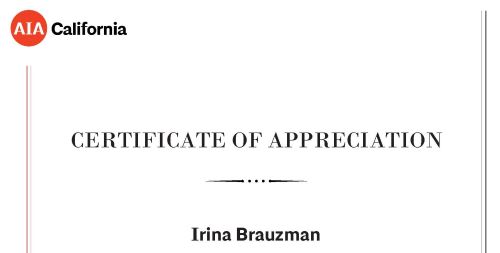
"As we conclude another transformative year at AIA California, I am writing to express our appreciation for your volunteer service throughout 2024.
Your dedication has been instrumental to our organization's success. The time, expertise, and commitment you have generously shared have made a meaningful difference in our architectural community.
In recognition of your remarkable efforts, we are pleased to [present] a Year-End Certificate of Appreciation. While we understand that no single document could fully capture the breadth and depth of your contributions, this certificate stands as representation of our deepest gratitude.
Your work embodies the very best of professional volunteerism: collaborative spirit, technical excellence, and unwavering commitment to our shared goals. The impact of your service extends well beyond the hours you have dedicated, creating lasting value for AIA California and the broader architectural profession.
As we reflect on the achievements of the past year and look forward to the opportunities ahead, we are grateful for volunteers like you who continue to elevate our organization and our profession.
Thank you!
Sarah Vasquez
Climate Action Program Coordinator
The American Institute of Architects California"
Codie's Den

Growl! (That’s bear-speak for “Hello!”) I’m Codie the Bear, and you’ll be seeing a lot of me this year as the mascot for the 2025 edition of the California Building Standards Code, Title 24 of the California Code of Regulations (Title 24). Nice to meet you!
I am coming out of torpor (California bears don’t actually hibernate, you know…) to share the news that the 2025 Title 24 is on schedule to be published on July 1 this year. What’s exciting about this new edition is that for the first time in a long time, there will be a new part of the code—one that is near and dear to my bear-y heart—the California Wildland-Urban Interface Code (CWUIC), Part 7 of Title 24. The CWUIC assembles in one location many regulations related to construction and fire and life safety where civilization meets the wilderness. It's safe to say California has a lot of that, right?
Currently, regulations related to fire and life safety in wildland-urban interface areas are in several different locations including:
California state laws:
- Public Resources Code
- Government Code
- Health and Safety Code
California Code of Regulations:
- Title 24, Part 2 California Building Code (CBC), Chapter 7A
- Title 24, Part 2.5 California Residential Code (CRC), Chapter 3, Section R337
- Title 24, Part 9 California Fire Code (CFC), Chapter 49
- Title 14, Natural Resources Code
- Title 19, Public Safety Code
By bringing all the wildland-urban interface laws and regulations into a single code book, designers, contractors, homeowners, and local jurisdictions will have a one-stop shop to find the laws and regulations needed for enforcement to keep their communities safe.
To accomplish this, the California State Fire Marshal (SFM) adopted and amended the International Wildland-Urban Interface Code (IWUIC), published by the International Code Council, for the first time. As with all model building codes adopted in the state, amendments are made by the responsible state agency—in this case, SFM—to align with requirements of California law, and to eliminate conflict with existing laws and regulations. The result is the California Wildland-Urban Interface Code, Part 7 of Title 24, that will be published July 1, 2025, and go into effect on January 1, 2026. The CWUIC contains the following chapters:
- Chapter 1 – Administrative provisions consistent with other parts of the Title 24.
- Chapter 2 – Definitions.
- Chapter 3 – Wildland-urban interface areas. This chapter explains how California establishes fire hazard severity zones.
- Chapter 4 – Wildland-urban interface area requirements. Establishes the access, water supply, and fire protection plan requirements based on designated fire hazard severity zones. This chapter incorporates sections from the California Fire Code, Chapters 5 and 49, as well as requirements found in Title 14 and other California statutes and regulations.
- Chapter 5 – Special building construction regulations. This chapter is where all existing requirements from the California Building Code Chapter 7A and the California Residential Code Chapter 3, Section R337, are now located.
- Chapter 6 – Fire protection requirements. Includes the establishment and maintenance of defensible space, and other items needed to protect structures in the wildland-urban interface areas. It contains regulations relocated from the California Fire Code.
- Chapter 7 – Referenced standards.
- There are also nine appendices (one is reserved), some of which are model code appendices with or without SFM amendments, and some that SFM developed and added to assist local agencies. The “Cross Reference Tool” in Appendix H lists each section of the CWUIC and identifies where the language in that section came from.
For more information about the development of the CWUIC, please visit CBSC’s 2024 Triennial Code Adoption Cycle webpage, which contains all of SFM’s code development documents. Recordings of the public meetings where the adoption of Part 7 was discussed can be found on CBSC’s YouTube channel. The Code Advisory Committee meeting was in July 2024, and the commission meeting where the regulations were approved and adopted was held in February 2025.
Here’s hoping you have a grrrreat spring and I’ll see you soon. Now, if I can just find some fresh berries…

Website Update - Making it Easier to Find CBSC Meetings
Education and Outreach
January 9 – Tokyo Metro Government Delegation Visits with CBSC and DSA
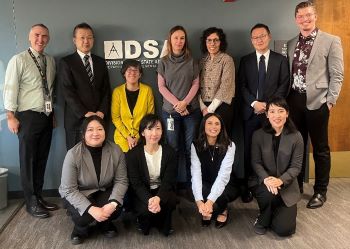
Back: Eric Driever (DSA), Shinichi Ohyabu (TMG [Tokyo Metropolitan Government]), Sayo Okata (Renewable Energy Institute – Japan), Irina Brauzman (CBSC), Alicia Chavez (DSA), Shunji Samejima (TMG), Scott Terel (AIA)
Front: Miki Ogawa (TMG), Megumi Horii (Nikken Sekkei Ltd. – Japan), Sarah Vasquez (AIA), Yukie Nakajima (Nikken Sekkei Research Institute – Japan)
A delegation from the city of Tokyo, Japan, requested a meeting with the principal state representatives involved in the development of embodied carbon reduction regulations adopted into the California Green Building Standards Code, Part 11 of Title 24 (CALGreen). The meeting was held at the office of the Division of the State Architect (DSA) in Sacramento and included representatives from the California Building Standards Commission (CBSC) and the American Institute of Architects, California (AIA-CA).
The discussion focused on a list of questions from the delegation regarding planning for implementation of the policy via the regulatory process, actual implementation, and public reaction to the policy. The exchange was educational and informative for all in attendance.
February 12 – Global Government-to-Government Partnership Fellow Visits with CBSC and DSA Representatives

Claudia Lorenz (Global Ties), Ida Clair (DSA), Stoyan Bumbalov (CBSC), Alicia Chavez (DSA), Eric Driever (DSA), Ryosuke Tanaka (G3P Fellow, Japan Ministry of Economy, Trade and Industry), Kevin Day (CBSC), Tim Freeman (CBSC)
Global Government-to-Government Partnership (G3P) fellows participate in both short-term and long-term fellowships and travel to cities across the United States to meet with leading organizations and thinkers in their respective fields. Once the program is complete, participants return to Japan to work in the development of their government and civil society. Mr. Tanaka’s visit was supported by Global Ties Sacramento, which influences positive global change and fosters mutual understanding through the facilitation of professional, cultural and educational exchanges.
The conversation with DSA and CBSC helped Mr. Tanaka understand building standards and the code development agencies’ relationship with other governmental entities. Global Ties’ “thank you” to CBSC indicated that he especially valued hearing a different perspective on how policies are implemented and coordinated across agencies, which provided him with a deeper understanding of regulatory processes in California.
March 3 – California Fire Protection Institute Training
Associate Construction Analyst Enrique Rodriquez spoke with California Fire Protection Institute (CFPI) members in a two-hour presentation at their annual meeting in Santa Barbara. CFPI students learned about the commission and its members, how the public participates in the code adoption process, how to effectively create and file local amendments to Title 24 (ordinances), and current updates to CALGreen. After a lively question-and-answer session, those in attendance had a deeper understanding of many topics relevant to their duties.
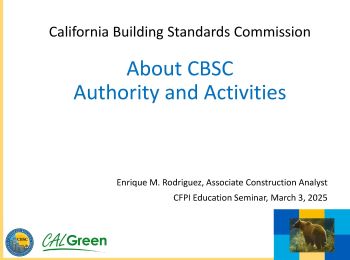
March 12 – U.S. Green Building Council Visits CBSC and DSA
Leaders from U.S. Green Building Council (USGBC) visited Sacramento and had a meet-and-greet with CBSC and DSA executive staff. The discussion focused on continued development of the building standards in CALGreen, and ongoing support and input from USGBC and its members. Attending the meeting were: USGBC’s Executive Director in California Ben Stapleton, along with Western States Policy Advisor Maria Balzer-Pisciotta; CBSC’s Executive Director Stoyan Bumbalov and Deputy Executive Director Kevin Day; and State Architect Ida Clair and Supervising Architect Alicia Chavez from DSA.

May 2025 Events
CBSC supports and promotes the International Code Council's Building Safety Month in May.
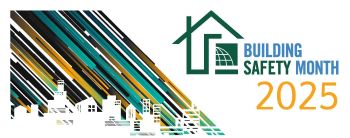
We hope to see you at Green Technology's Sustainable Facilities Forum on May 15. Hear keynote speakers, visit vendor displays, and attend educational sessions. CBSC Associate Construction Analyst Enrique Rodriquez will present information about CALGreen nonresidential code updates.
